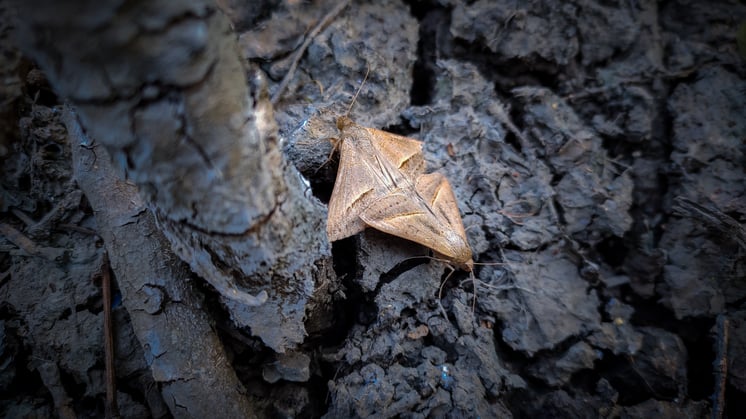With Valentine’s Day just passed, love is in the air and what better time is there to dive into the fascinating world of animal pheromones. Pheromones are chemical scent molecules released by a species to elicit a specific response in another member of their same species. These chemicals can be transferred by wind or water currents or shared via direct contact. Pheromone communication has been identified in species across the animal kingdom, from insects to mammals. Although often an important part of courting rituals, pheromones control so much more than just sex.
 Two Moths Mating on the Ground
Two Moths Mating on the Ground
Among social insects like ants and bees, pheromones dictate almost every aspect of communal living. In bee colonies, pheromones from the queen bee signals to the other members of the hive to remain sterile. While any honeybee larvae is born with the ability to become a queen, only the larvae fed royal jelly will develop into queen bees. The secret ingredient to the royal jelly is the aptly named pheromone “royalactin”.
Moths are masters of using pheromones to consummate their long-distance relationships. Female moths release a pheromone that travels through the air until it reaches the antenna of a male. The male will follow the pheromone molecules in a zigzag pattern until they locate the female. And it turns out, humans aren’t the only ones who have to worry about being catfished when it comes to dating. Some species of spiders have evolved to mimic the sex pheromones of their prey, luring unsuspecting insects to their webs. Orchid flowers mimic the sex pheromones of wasps to entice pollinators to their petals.
Scientists and farmers have also learned to take advantage of insect pheromones to combat pests. Entomologists released the laboratory-created sex pheromones of pest moths to confuse males and disrupt their mating as an eco-friendly form of pest control. Because pheromones are incredibly species-specific, the release of pheromones only affects the moth, leaving other beneficial insects unharmed. In Colorado, pheromones have been used to deter pine beetles from infesting vulnerable pine trees. Pheromone packets from male pine beetles are attached to the trees to send out an “I’m occupied!” territorial signal to other pine beetles.
Pheromones are not only important to insect communication, mammals also depend on them. Mother rabbits release a pheromone after giving birth that helps their kits find their nipple to feed. The same pheromone used in rabbits to help kits find their mother’s milk has been found to have an effect on dogs, causing heart rate to decrease in nervous dogs and increase in calm dogs. Other mammals that use pheromones include pigs, elephants, goats, mice and other rodents.
Despite its popularity, the term ‘pheromone’ is sometimes misused in popular culture. In a study at the University of Utah, scientists observed that mice are generally attracted to other mice with a different immunology makeup than themselves. These differences can be detected by smell, which inspired humans to begin hosting “pheromone parties” where singles smelled the dirty t-shirts of other singles in order to choose who to date. While fun, these parties are not actually using pheromonal cues, because pheromones must be consistent across a species and not vary from individual to individual. Humans likely use pheromones to communicate, but despite the promises of various perfumes and supplements, no “human pheromone molecule” has yet to be identified. There is still much to be discovered in the fascinating world of pheromones.
Rachel Dorencz is a Community Programs Manager at Walking Mountains Science Center. Her favorite pheromone-releasing animal is her pet rabbit, Bunbun.







